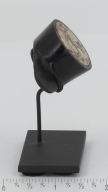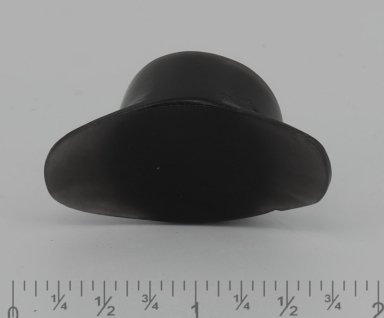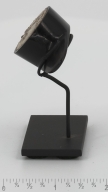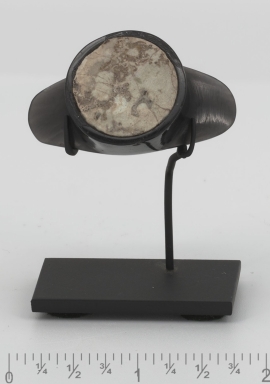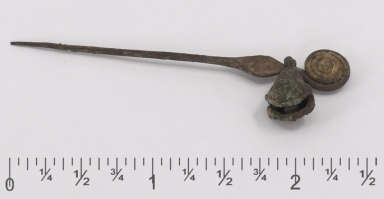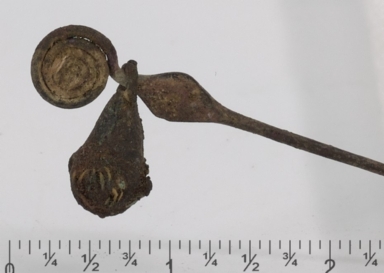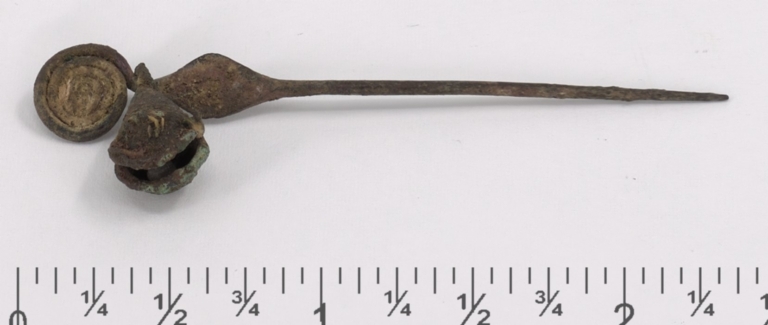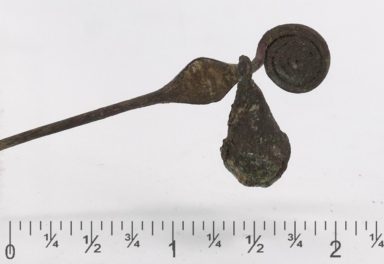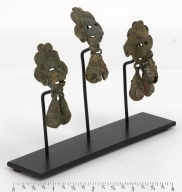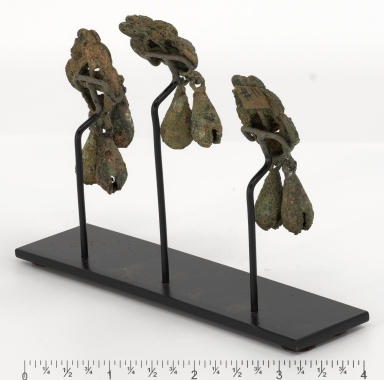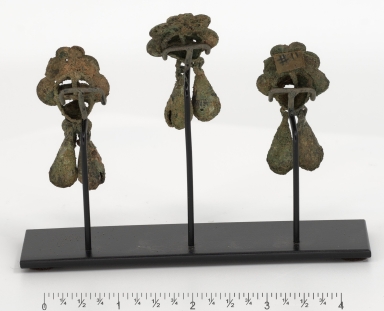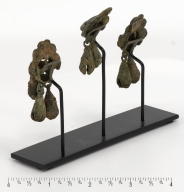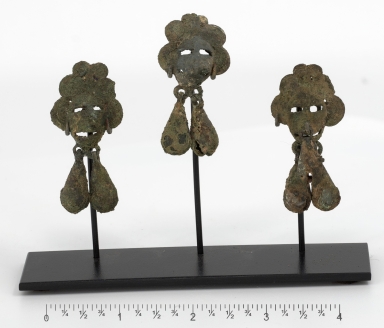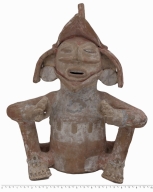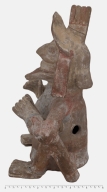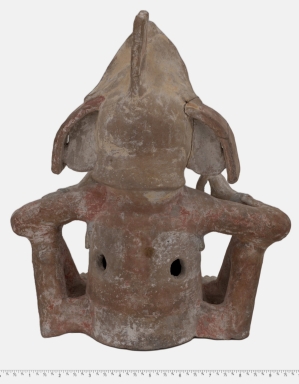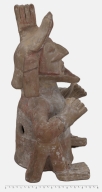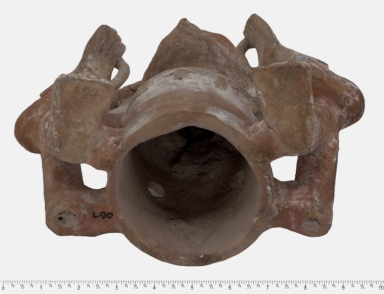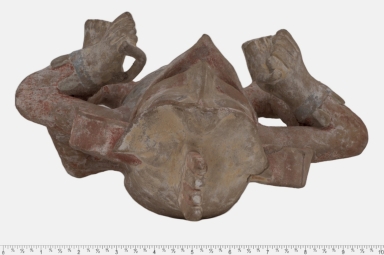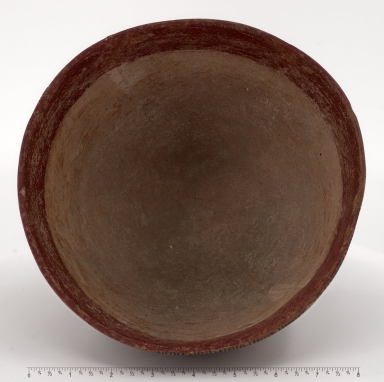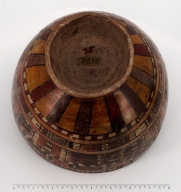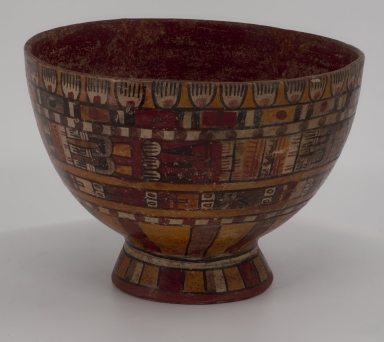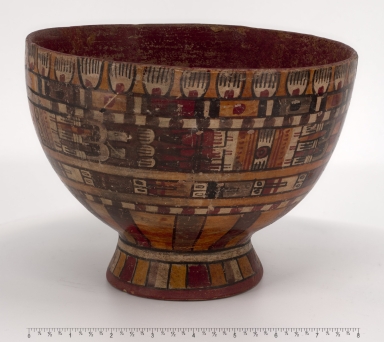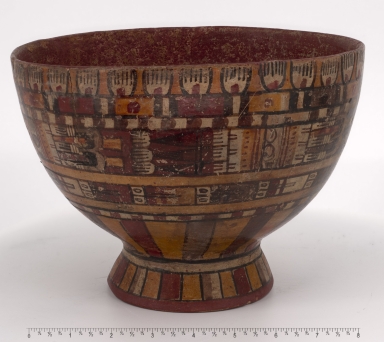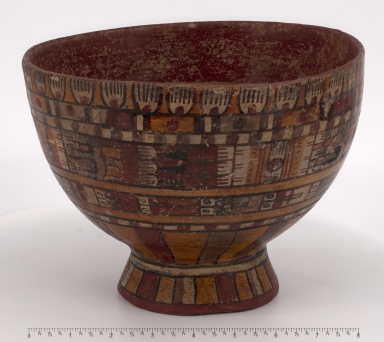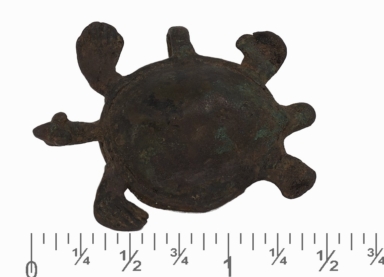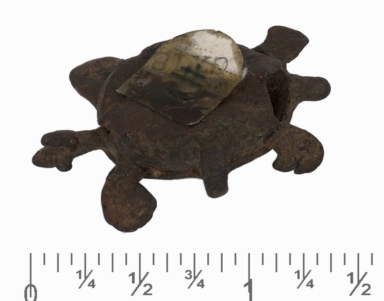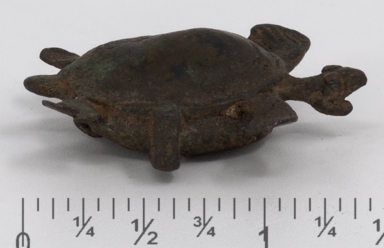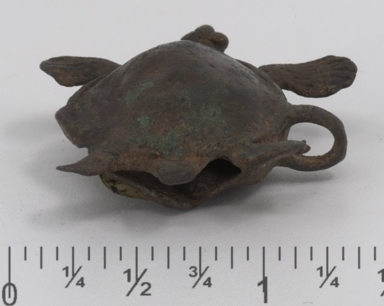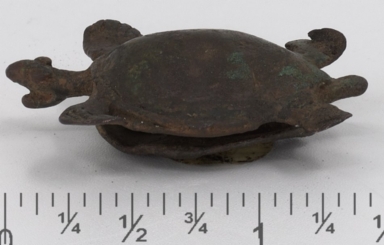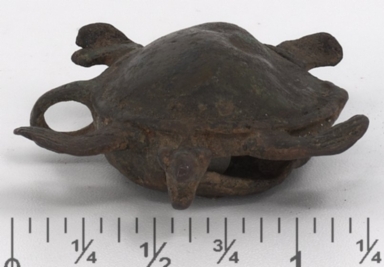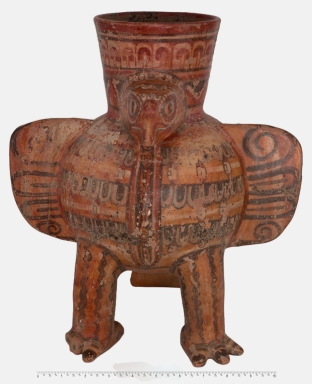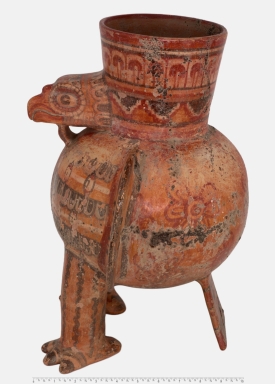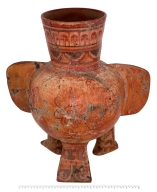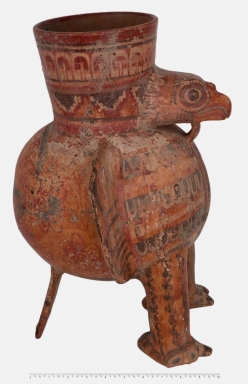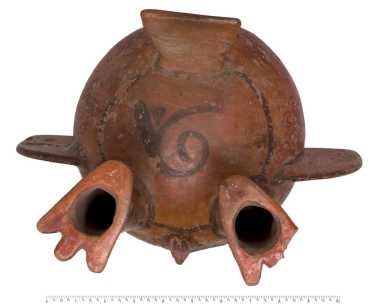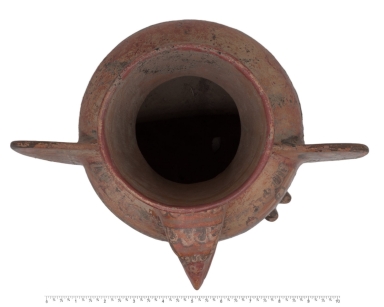|
REFINE
Browse All : Indigenous Peoples--Antiquities and Artifact
1-38 of 38
Title
Three obsidian winged labrets : B.
Description
Obsidian is a volcanic glass-like stone cleaves concavely. Working with obsidian requires great skill. The process involves core flaking, pressure flaking, drilling, abrading as well as polishing. It is very labor intesive. Two of the labrets have been inlaid with a white material.
Subject
[Labrets, Jewelry--Mexico, Stone carving--Mexico, Obsidian--Mexico, Art--Mexico, Indigenous Peoples--Antiquities]
Date
between 900 and 1523
Title
Three obsidian winged labrets : B.
Description
Obsidian is a volcanic glass-like stone cleaves concavely. Working with obsidian requires great skill. The process involves core flaking, pressure flaking, drilling, abrading as well as polishing. It is very labor intesive. Two of the labrets have been inlaid with a white material.
Subject
[Labrets, Jewelry--Mexico, Stone carving--Mexico, Obsidian--Mexico, Art--Mexico, Indigenous Peoples--Antiquities]
Date
between 900 and 1523
Title
Three obsidian winged labrets : B.
Description
Obsidian is a volcanic glass-like stone cleaves concavely. Working with obsidian requires great skill. The process involves core flaking, pressure flaking, drilling, abrading as well as polishing. It is very labor intesive. Two of the labrets have been inlaid with a white material.
Subject
[Labrets, Jewelry--Mexico, Stone carving--Mexico, Obsidian--Mexico, Art--Mexico, Indigenous Peoples--Antiquities]
Date
between 900 and 1523
Title
Three obsidian winged labrets : B.
Description
Obsidian is a volcanic glass-like stone cleaves concavely. Working with obsidian requires great skill. The process involves core flaking, pressure flaking, drilling, abrading as well as polishing. It is very labor intesive. Two of the labrets have been inlaid with a white material.
Subject
[Labrets, Jewelry--Mexico, Stone carving--Mexico, Obsidian--Mexico, Art--Mexico, Indigenous Peoples--Antiquities]
Date
between 900 and 1523
Title
Small copper pin.
Description
Metallurgy in copper was popular in Mixtec times. The art of metalworking was introduced around AD 800 into West Mexico from Central or South America
Subject
[Pins and needles--Mexico, Art--Mexico, Indigenous Peoples--Antiquities]
Date
between 900 and 1200
Title
Small copper pin.
Description
Metallurgy in copper was popular in Mixtec times. The art of metalworking was introduced around AD 800 into West Mexico from Central or South America
Subject
[Pins and needles--Mexico, Art--Mexico, Indigenous Peoples--Antiquities]
Date
between 900 and 1200
Title
Small copper pin.
Description
Metallurgy in copper was popular in Mixtec times. The art of metalworking was introduced around AD 800 into West Mexico from Central or South America
Subject
[Pins and needles--Mexico, Art--Mexico, Indigenous Peoples--Antiquities]
Date
between 900 and 1200
Title
Small copper pin.
Description
Metallurgy in copper was popular in Mixtec times. The art of metalworking was introduced around AD 800 into West Mexico from Central or South America
Subject
[Pins and needles--Mexico, Art--Mexico, Indigenous Peoples--Antiquities]
Date
between 900 and 1200
Title
Copper human face pendant : 2.
Description
These hollow, open-back copper masks were cast usin the lost wax technique. There is a strap across the back so they could be secured to a headdress or a textile. The masks contained small bells which would tingle when moved.
Subject
[Pendants (Jewelry)--Mexico, Purépecha art--Antiquities, Mixtec art--Antiquities, Aztec art--Mexico, Indigenous Peoples--Antiquities]
Date
between 900 and 1200
Title
Copper human face pendant : 2.
Description
These hollow, open-back copper masks were cast usin the lost wax technique. There is a strap across the back so they could be secured to a headdress or a textile. The masks contained small bells which would tingle when moved.
Subject
[Pendants (Jewelry)--Mexico, Purépecha art--Antiquities, Mixtec art--Antiquities, Aztec art--Mexico, Indigenous Peoples--Antiquities]
Date
between 900 and 1200
Title
Copper human face pendant : 2.
Description
These hollow, open-back copper masks were cast usin the lost wax technique. There is a strap across the back so they could be secured to a headdress or a textile. The masks contained small bells which would tingle when moved.
Subject
[Pendants (Jewelry)--Mexico, Purépecha art--Antiquities, Mixtec art--Antiquities, Aztec art--Mexico, Indigenous Peoples--Antiquities]
Date
between 900 and 1200
Title
Copper human face pendant : 2.
Description
These hollow, open-back copper masks were cast usin the lost wax technique. There is a strap across the back so they could be secured to a headdress or a textile. The masks contained small bells which would tingle when moved.
Subject
[Pendants (Jewelry)--Mexico, Purépecha art--Antiquities, Mixtec art--Antiquities, Aztec art--Mexico, Indigenous Peoples--Antiquities]
Date
between 900 and 1200
Title
Copper human face pendant : 2.
Description
These hollow, open-back copper masks were cast usin the lost wax technique. There is a strap across the back so they could be secured to a headdress or a textile. The masks contained small bells which would tingle when moved.
Subject
[Pendants (Jewelry)--Mexico, Purépecha art--Antiquities, Mixtec art--Antiquities, Aztec art--Mexico, Indigenous Peoples--Antiquities]
Date
between 900 and 1200
Title
Copper human face pendant : 2.
Description
These hollow, open-back copper masks were cast usin the lost wax technique. There is a strap across the back so they could be secured to a headdress or a textile. The masks contained small bells which would tingle when moved.
Subject
[Pendants (Jewelry)--Mexico, Purépecha art--Antiquities, Mixtec art--Antiquities, Aztec art--Mexico, Indigenous Peoples--Antiquities]
Date
between 900 and 1200
Title
Anthropomorphic xantil : cult image : incense burner.
Description
Burning Copal incense in the body of the Xantil produced a dense sweet smoke which emerges from his mouth. Xochipilli-Macuilxochitl, the young solar diety of sensuality, will appear to be chanting or singing. The god wears a bird-hed helmet with a crest, a long nose bar, a pair of round ear ornaments, a white collar, bracelets and knotted sandals.
Subject
[Ceramic sculpture--Mexico--Oaxaca (State), Mixtec art--Mexico--Oaxaca (State), Indigenous Peoples--Antiquities]
Date
between 1200 and 1521
Title
Anthropomorphic xantil : cult image : incense burner.
Description
Burning Copal incense in the body of the Xantil produced a dense sweet smoke which emerges from his mouth. Xochipilli-Macuilxochitl, the young solar diety of sensuality, will appear to be chanting or singing. The god wears a bird-hed helmet with a crest, a long nose bar, a pair of round ear ornaments, a white collar, bracelets and knotted sandals.
Subject
[Ceramic sculpture--Mexico--Oaxaca (State), Mixtec art--Mexico--Oaxaca (State), Indigenous Peoples--Antiquities]
Date
between 1200 and 1521
Title
Anthropomorphic xantil : cult image : incense burner.
Description
Burning Copal incense in the body of the Xantil produced a dense sweet smoke which emerges from his mouth. Xochipilli-Macuilxochitl, the young solar diety of sensuality, will appear to be chanting or singing. The god wears a bird-hed helmet with a crest, a long nose bar, a pair of round ear ornaments, a white collar, bracelets and knotted sandals.
Subject
[Ceramic sculpture--Mexico--Oaxaca (State), Mixtec art--Mexico--Oaxaca (State), Indigenous Peoples--Antiquities]
Date
between 1200 and 1521
Title
Anthropomorphic xantil : cult image : incense burner.
Description
Burning Copal incense in the body of the Xantil produced a dense sweet smoke which emerges from his mouth. Xochipilli-Macuilxochitl, the young solar diety of sensuality, will appear to be chanting or singing. The god wears a bird-hed helmet with a crest, a long nose bar, a pair of round ear ornaments, a white collar, bracelets and knotted sandals.
Subject
[Ceramic sculpture--Mexico--Oaxaca (State), Mixtec art--Mexico--Oaxaca (State), Indigenous Peoples--Antiquities]
Date
between 1200 and 1521
Title
Anthropomorphic xantil : cult image : incense burner.
Description
Burning Copal incense in the body of the Xantil produced a dense sweet smoke which emerges from his mouth. Xochipilli-Macuilxochitl, the young solar diety of sensuality, will appear to be chanting or singing. The god wears a bird-hed helmet with a crest, a long nose bar, a pair of round ear ornaments, a white collar, bracelets and knotted sandals.
Subject
[Ceramic sculpture--Mexico--Oaxaca (State), Mixtec art--Mexico--Oaxaca (State), Indigenous Peoples--Antiquities]
Date
between 1200 and 1521
Title
Anthropomorphic xantil : cult image : incense burner.
Description
Burning Copal incense in the body of the Xantil produced a dense sweet smoke which emerges from his mouth. Xochipilli-Macuilxochitl, the young solar diety of sensuality, will appear to be chanting or singing. The god wears a bird-hed helmet with a crest, a long nose bar, a pair of round ear ornaments, a white collar, bracelets and knotted sandals.
Subject
[Ceramic sculpture--Mexico--Oaxaca (State), Mixtec art--Mexico--Oaxaca (State), Indigenous Peoples--Antiquities]
Date
between 1200 and 1521
Title
Mixtec Pedestal Bowl: Mixcoatl Motif
Description
The Eastern Nahua participated in elaborate gatherings that brought various groups together to cement social and political relationships. Entertainment required story telling, gift giving, eating, and drinking. This beautifully painted pedestal bowl was perhaps a cherished gift used to drink pulque.
Subject
[Ceramic bowls--Mexico--Puebla de Zaragoza, Pottery--Mexico--Puebla de Zaragoza, Nahua art--Mexico--Puebla de Zaragoza, Nahuas--Antiquities, Indigenous Peoples--Antiquities]
Date
between 900 and 1200
Title
Mixtec Pedestal Bowl: Mixcoatl Motif
Description
The Eastern Nahua participated in elaborate gatherings that brought various groups together to cement social and political relationships. Entertainment required story telling, gift giving, eating, and drinking. This beautifully painted pedestal bowl was perhaps a cherished gift used to drink pulque.
Subject
[Ceramic bowls--Mexico--Puebla de Zaragoza, Pottery--Mexico--Puebla de Zaragoza, Nahua art--Mexico--Puebla de Zaragoza, Nahuas--Antiquities, Indigenous Peoples--Antiquities]
Date
between 900 and 1200
Title
Mixtec Pedestal Bowl: Mixcoatl Motif
Description
The Eastern Nahua participated in elaborate gatherings that brought various groups together to cement social and political relationships. Entertainment required story telling, gift giving, eating, and drinking. This beautifully painted pedestal bowl was perhaps a cherished gift used to drink pulque.
Subject
[Ceramic bowls--Mexico--Puebla de Zaragoza, Pottery--Mexico--Puebla de Zaragoza, Nahua art--Mexico--Puebla de Zaragoza, Nahuas--Antiquities, Indigenous Peoples--Antiquities]
Date
between 900 and 1200
Title
Mixtec Pedestal Bowl: Mixcoatl Motif
Description
The Eastern Nahua participated in elaborate gatherings that brought various groups together to cement social and political relationships. Entertainment required story telling, gift giving, eating, and drinking. This beautifully painted pedestal bowl was perhaps a cherished gift used to drink pulque.
Subject
[Ceramic bowls--Mexico--Puebla de Zaragoza, Pottery--Mexico--Puebla de Zaragoza, Nahua art--Mexico--Puebla de Zaragoza, Nahuas--Antiquities, Indigenous Peoples--Antiquities]
Date
between 900 and 1200
Title
Mixtec Pedestal Bowl: Mixcoatl Motif
Description
The Eastern Nahua participated in elaborate gatherings that brought various groups together to cement social and political relationships. Entertainment required story telling, gift giving, eating, and drinking. This beautifully painted pedestal bowl was perhaps a cherished gift used to drink pulque.
Subject
[Ceramic bowls--Mexico--Puebla de Zaragoza, Pottery--Mexico--Puebla de Zaragoza, Nahua art--Mexico--Puebla de Zaragoza, Nahuas--Antiquities, Indigenous Peoples--Antiquities]
Date
between 900 and 1200
Title
Mixtec Pedestal Bowl: Mixcoatl Motif
Description
The Eastern Nahua participated in elaborate gatherings that brought various groups together to cement social and political relationships. Entertainment required story telling, gift giving, eating, and drinking. This beautifully painted pedestal bowl was perhaps a cherished gift used to drink pulque.
Subject
[Ceramic bowls--Mexico--Puebla de Zaragoza, Pottery--Mexico--Puebla de Zaragoza, Nahua art--Mexico--Puebla de Zaragoza, Nahuas--Antiquities, Indigenous Peoples--Antiquities]
Date
between 900 and 1200
Title
Copper turtle bell pendant.
Description
The turtle bell was first formed with beeswax. Then the turtle bell wax model was embedded in a fine clay material. The clay matrix and the beeswax mold was slowly heated to melt the wax; hardening the clay mixture and creating a hollow negative turtle space. Molten copper was poured into the hollow space; it hardened and formed the turtle bell.
Subject
[Pendants (Jewelry)--Mexico, Decoration and ornament--Mexico, Purépecha art--Mexico, Mixtec art--Mexico, Aztec art--Mexico, Turtles--Art, Indigenous Peoples--Antiquities]
Date
between 900 and 1200
Title
Copper turtle bell pendant.
Description
The turtle bell was first formed with beeswax. Then the turtle bell wax model was embedded in a fine clay material. The clay matrix and the beeswax mold was slowly heated to melt the wax; hardening the clay mixture and creating a hollow negative turtle space. Molten copper was poured into the hollow space; it hardened and formed the turtle bell.
Subject
[Pendants (Jewelry)--Mexico, Decoration and ornament--Mexico, Purépecha art--Mexico, Mixtec art--Mexico, Aztec art--Mexico, Turtles--Art, Indigenous Peoples--Antiquities]
Date
between 900 and 1200
Title
Copper turtle bell pendant.
Description
The turtle bell was first formed with beeswax. Then the turtle bell wax model was embedded in a fine clay material. The clay matrix and the beeswax mold was slowly heated to melt the wax; hardening the clay mixture and creating a hollow negative turtle space. Molten copper was poured into the hollow space; it hardened and formed the turtle bell.
Subject
[Pendants (Jewelry)--Mexico, Decoration and ornament--Mexico, Purépecha art--Mexico, Mixtec art--Mexico, Aztec art--Mexico, Turtles--Art, Indigenous Peoples--Antiquities]
Date
between 900 and 1200
Title
Copper turtle bell pendant.
Description
The turtle bell was first formed with beeswax. Then the turtle bell wax model was embedded in a fine clay material. The clay matrix and the beeswax mold was slowly heated to melt the wax; hardening the clay mixture and creating a hollow negative turtle space. Molten copper was poured into the hollow space; it hardened and formed the turtle bell.
Subject
[Pendants (Jewelry)--Mexico, Decoration and ornament--Mexico, Purépecha art--Mexico, Mixtec art--Mexico, Aztec art--Mexico, Turtles--Art, Indigenous Peoples--Antiquities]
Date
between 900 and 1200
Title
Copper turtle bell pendant.
Description
The turtle bell was first formed with beeswax. Then the turtle bell wax model was embedded in a fine clay material. The clay matrix and the beeswax mold was slowly heated to melt the wax; hardening the clay mixture and creating a hollow negative turtle space. Molten copper was poured into the hollow space; it hardened and formed the turtle bell.
Subject
[Pendants (Jewelry)--Mexico, Decoration and ornament--Mexico, Purépecha art--Mexico, Mixtec art--Mexico, Aztec art--Mexico, Turtles--Art, Indigenous Peoples--Antiquities]
Date
between 900 and 1200
Title
Copper turtle bell pendant.
Description
The turtle bell was first formed with beeswax. Then the turtle bell wax model was embedded in a fine clay material. The clay matrix and the beeswax mold was slowly heated to melt the wax; hardening the clay mixture and creating a hollow negative turtle space. Molten copper was poured into the hollow space; it hardened and formed the turtle bell.
Subject
[Pendants (Jewelry)--Mexico, Decoration and ornament--Mexico, Purépecha art--Mexico, Mixtec art--Mexico, Aztec art--Mexico, Turtles--Art, Indigenous Peoples--Antiquities]
Date
between 900 and 1200
Title
Eagle effigy vessel : avian form.
Description
The harpy eagle is the largest bird predator in Mexico and Central America. With power and speed, it is able to fly through the junble canopy and catch a monkey. The Mixtec admired the skills of the harpy eagle and used the eagly as part of their iconography. On this harpy eagle vessel, there are rows of feathers and between some of the rows there are flint blade knives tipped with red blood.
Subject
[Effigy pottery--Mexico--Puebla de Zaragoza, Ceramic tableware--Mexico--Puebla de Zaragoza, Nahuas--Antiquities, Nahua art--Mexico--Puebla de Zaragoza, Indigenous Peoples--Antiquities]
Date
between 1250 and 1521
Title
Eagle effigy vessel : avian form.
Description
The harpy eagle is the largest bird predator in Mexico and Central America. With power and speed, it is able to fly through the junble canopy and catch a monkey. The Mixtec admired the skills of the harpy eagle and used the eagly as part of their iconography. On this harpy eagle vessel, there are rows of feathers and between some of the rows there are flint blade knives tipped with red blood.
Subject
[Effigy pottery--Mexico--Puebla de Zaragoza, Ceramic tableware--Mexico--Puebla de Zaragoza, Nahuas--Antiquities, Nahua art--Mexico--Puebla de Zaragoza, Indigenous Peoples--Antiquities]
Date
between 1250 and 1521
Title
Eagle effigy vessel : avian form.
Description
The harpy eagle is the largest bird predator in Mexico and Central America. With power and speed, it is able to fly through the junble canopy and catch a monkey. The Mixtec admired the skills of the harpy eagle and used the eagly as part of their iconography. On this harpy eagle vessel, there are rows of feathers and between some of the rows there are flint blade knives tipped with red blood.
Subject
[Effigy pottery--Mexico--Puebla de Zaragoza, Ceramic tableware--Mexico--Puebla de Zaragoza, Nahuas--Antiquities, Nahua art--Mexico--Puebla de Zaragoza, Indigenous Peoples--Antiquities]
Date
between 1250 and 1521
Title
Eagle effigy vessel : avian form.
Description
The harpy eagle is the largest bird predator in Mexico and Central America. With power and speed, it is able to fly through the junble canopy and catch a monkey. The Mixtec admired the skills of the harpy eagle and used the eagly as part of their iconography. On this harpy eagle vessel, there are rows of feathers and between some of the rows there are flint blade knives tipped with red blood.
Subject
[Effigy pottery--Mexico--Puebla de Zaragoza, Ceramic tableware--Mexico--Puebla de Zaragoza, Nahuas--Antiquities, Nahua art--Mexico--Puebla de Zaragoza, Indigenous Peoples--Antiquities]
Date
between 1250 and 1521
Title
Eagle effigy vessel : avian form.
Description
The harpy eagle is the largest bird predator in Mexico and Central America. With power and speed, it is able to fly through the junble canopy and catch a monkey. The Mixtec admired the skills of the harpy eagle and used the eagly as part of their iconography. On this harpy eagle vessel, there are rows of feathers and between some of the rows there are flint blade knives tipped with red blood.
Subject
[Effigy pottery--Mexico--Puebla de Zaragoza, Ceramic tableware--Mexico--Puebla de Zaragoza, Nahuas--Antiquities, Nahua art--Mexico--Puebla de Zaragoza, Indigenous Peoples--Antiquities]
Date
between 1250 and 1521
Title
Eagle effigy vessel : avian form.
Description
The harpy eagle is the largest bird predator in Mexico and Central America. With power and speed, it is able to fly through the junble canopy and catch a monkey. The Mixtec admired the skills of the harpy eagle and used the eagly as part of their iconography. On this harpy eagle vessel, there are rows of feathers and between some of the rows there are flint blade knives tipped with red blood.
Subject
[Effigy pottery--Mexico--Puebla de Zaragoza, Ceramic tableware--Mexico--Puebla de Zaragoza, Nahuas--Antiquities, Nahua art--Mexico--Puebla de Zaragoza, Indigenous Peoples--Antiquities]
Date
between 1250 and 1521
1-38 of 38
|
